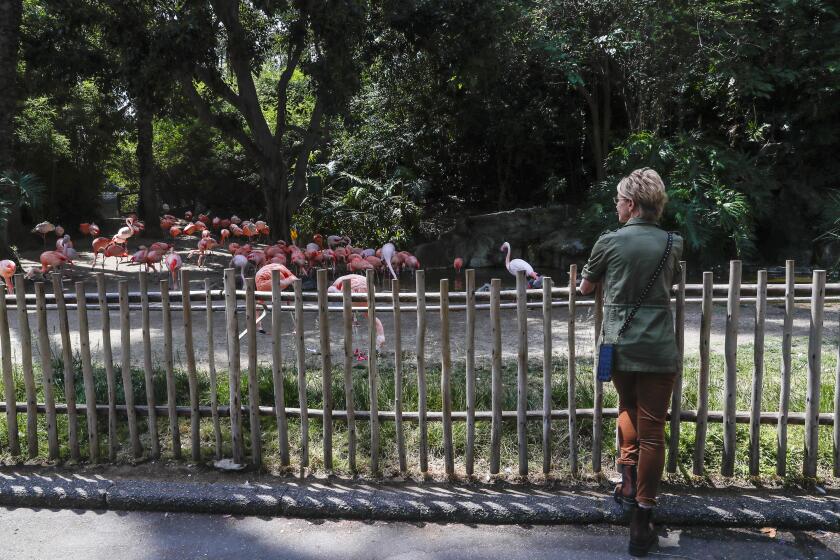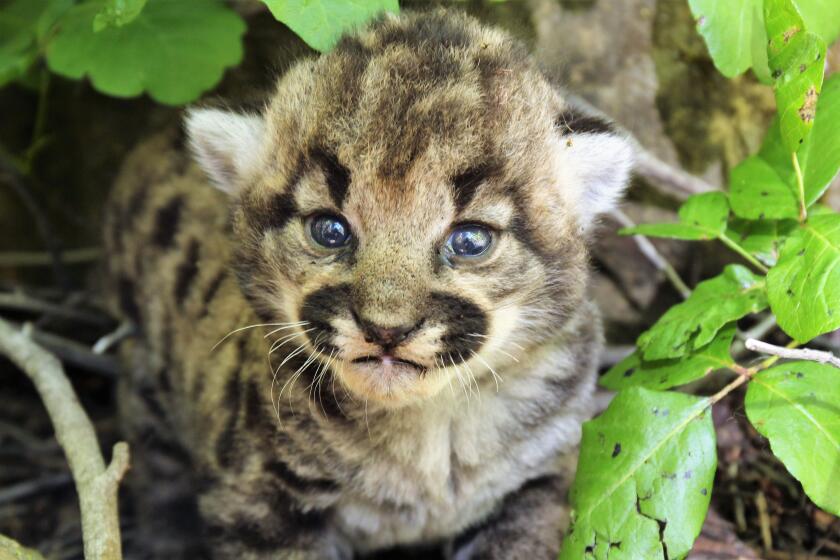Commentary: I was lucky to see a baby elephant up close, but it’s time to rethink keeping these majestic animals in zoos

- Share via
When I read the email from the Oakland Zoo last month saying it had retired its single remaining African elephant, a 30-year-old 15,000-pound bull named Osh, to the Elephant Sanctuary in Tennessee, I immediately thought of a much tinier elephant that once lived at the zoo.
One cloudy winter morning in 1996, I arrived at the Oakland Zoo, along with Times photographer Genaro Molina, where we found the subject of the story we had traveled to the Bay Area for: a 3-month-old baby African elephant named Kijana. His mother had rejected him after giving birth, so the zookeepers embarked upon a difficult and expensive mission to raise him.
When we first met him, he was wandering outside his barn while staffers went about their chores. His back was draped with a blanket for warmth. I hesitated to approach him. At 38 inches high and 304 pounds, he was smallish — but he was still an elephant.
Recovering from foot surgery, the 47-year-old Asian elephant is one popular pachyderm on her leisurely morning walks at the Los Angeles Zoo.
Genaro knelt on one knee as he started shooting pictures, and Kijana, ever curious, trotted over and wrapped his trunk around the lenses, then moved on to the photographer’s hair. Genaro grinned and kept shooting. I walked over and Kijana, using his trunk, effortlessly untied my shoelaces. We quickly learned if he extended his trunk up, he wanted you to rub it between the palms of your hands. He was just a pachyderm version of a golden retriever. His idea of play was to come up behind you and head-butt you, which, at his size, could move you along. (Later, as he grew older and stronger, zookeepers got him a goat to play with. )
By the time we left, I adored him. So did his keepers. They were determined to raise him to the point where he didn’t need them. They bottle-fed him special formula flown in from Canada. Colleen Kinzley, the zoo’s elephant manager at the time, slept in the barn next to him to keep watch over him. He in turn used his trunk to play with her hair at night and followed her around by day. The keepers prepared for the day they would introduce him to the other elephants in the zoo’s herd.
But Kijana never made it that far. At 11 months, a virus attacked his body. The zoo administered medication, but he died in the middle of the night with Kinzley at his side.
Zoos need to build and renovate. But the focus should be on animal welfare and conservation.
When I heard, I called the zoo for a comment and asked to speak to Kinzley. I was told she couldn’t come to the phone. It’s good she didn’t, because if I had spoken to her, I probably would have started sobbing on the phone at my desk in the newsroom. Instead I made it to the restroom and cried there.
Had Kijana lived, he would be turning 29 and might be on his way to a sanctuary. Instead it was Osh who was transported to Tennessee accompanied by zoo staff, including the zoological manager, Gina Kinzley (sister-in-law of Colleen, who is now vice president of animal care at the zoo). Gina stayed five days to watch him get settled into his portion of the 3,000-acre sanctuary. Then she bade him farewell. “As bittersweet as it was,” Gina says, “it was the best decision for Osh and his future.”
I know how privileged I was as a reporter to have the opportunity to interact with Kijana at a brief stage in his life when he couldn’t hurt us, allowing a rare up-close look at a wild animal, endangered and illegally poached for its tusks. Years later, at the Los Angeles Zoo, I accompanied keepers on a morning walk with their gentle female Asian elephant, Gita, around the grounds before the zoo opened to the public. In her barn, I fed her, plopping a corn cob into her open mouth. Just months later, Gita would collapse in her enclosure and die.
P-77’s litter was found in a den in Simi Hills. What kind of life will these three pumas have if we don’t stop running them down on the roads and poisoning them with rodenticides?
Few of us will ever visit Africa and see elephants in the wild. And if zoos stop exhibiting elephants, we won’t be able to see them in our cities. In zoos, animals don’t have to avoid predators or hunt their next meal, but they pay for that with a life in captivity.
Both the Oakland and Los Angeles zoos have had to rethink how to accommodate the largest land mammal on Earth. They long ago adopted the practice of “protected contact’’ that puts a barrier between keepers and elephants and eliminates the need to physically discipline the animals. Both zoos were among the first to banish the hurtful bullhook — now outlawed in the entire state.
Both have sent female African elephants to sanctuaries — Ruby at the L.A. Zoo to a California sanctuary, where she died at age 50 four years after she got there, and Donna in Oakland, who moved to the Tennessee sanctuary last year. That left Osh on his own until he too went to Tennessee.
Sanctuaries generally have hundreds of acres for elephants to roam. At the Oakland Zoo, elephants had six acres. But as Chief Executive Nik Dehejia told me it’s not just about space. Right now, he says, the zoo would have to renovate the area significantly to provide all the enrichment, structures and support a multigenerational herd of elephants would need, which would take time and money. So bringing elephants back to Oakland seems unlikely, he says. “What is the future of zoos in the next 30, 50 years?” he asks. “All of those factors go into thinking carefully about our role and where we can support animals in need and what are the right species we need to care for.”
Nearly three dozen accredited North American zoos have gotten out of the elephant-keeping business. Critics have long called for the Los Angeles Zoo to retire all its elephants — even after the zoo opened a $42-million exhibit for Asian elephants in 2010 with more than three acres of outdoor space featuring sandy hills, a waterfall and bathing pools. After the L.A. Zoo’s 61-year-old Jewel and 53-year-old Shaunzi were euthanized for health issues, the Los Angeles City Council in May ordered the zoo, a city agency, to report back on what led to their problems.
Still remaining are a female Asian elephant, Tina, and the zoo’s longtime Asian bull, Billy, who for decades has engaged in head-bobbing and swaying, which the zoo has said is a harmless habit and animal welfare advocates have said can be a sign of stress. “If it were up to me, I would say we should do what Oakland did,” said Councilmember Bob Blumenfield, who along with Councilmember Eunisses Hernandez introduced the motion calling for the study. “Retire elephants and send them to a sanctuary. It would be more humane.” A zoo spokesman says the zoo is always evaluating its programs and its “commitment to the care and well-being of our animals is unwavering.”
I don’t doubt the zoo works hard to take care of its elephants. But it may be beyond the zoo’s capacity to provide what they need. That’s what the editorial board wrote three years ago calling for the zoo to retire Billy. If he leaves, I will miss visiting him. But he and all elephants should be where they can live their best lives.
More to Read
A cure for the common opinion
Get thought-provoking perspectives with our weekly newsletter.
You may occasionally receive promotional content from the Los Angeles Times.













